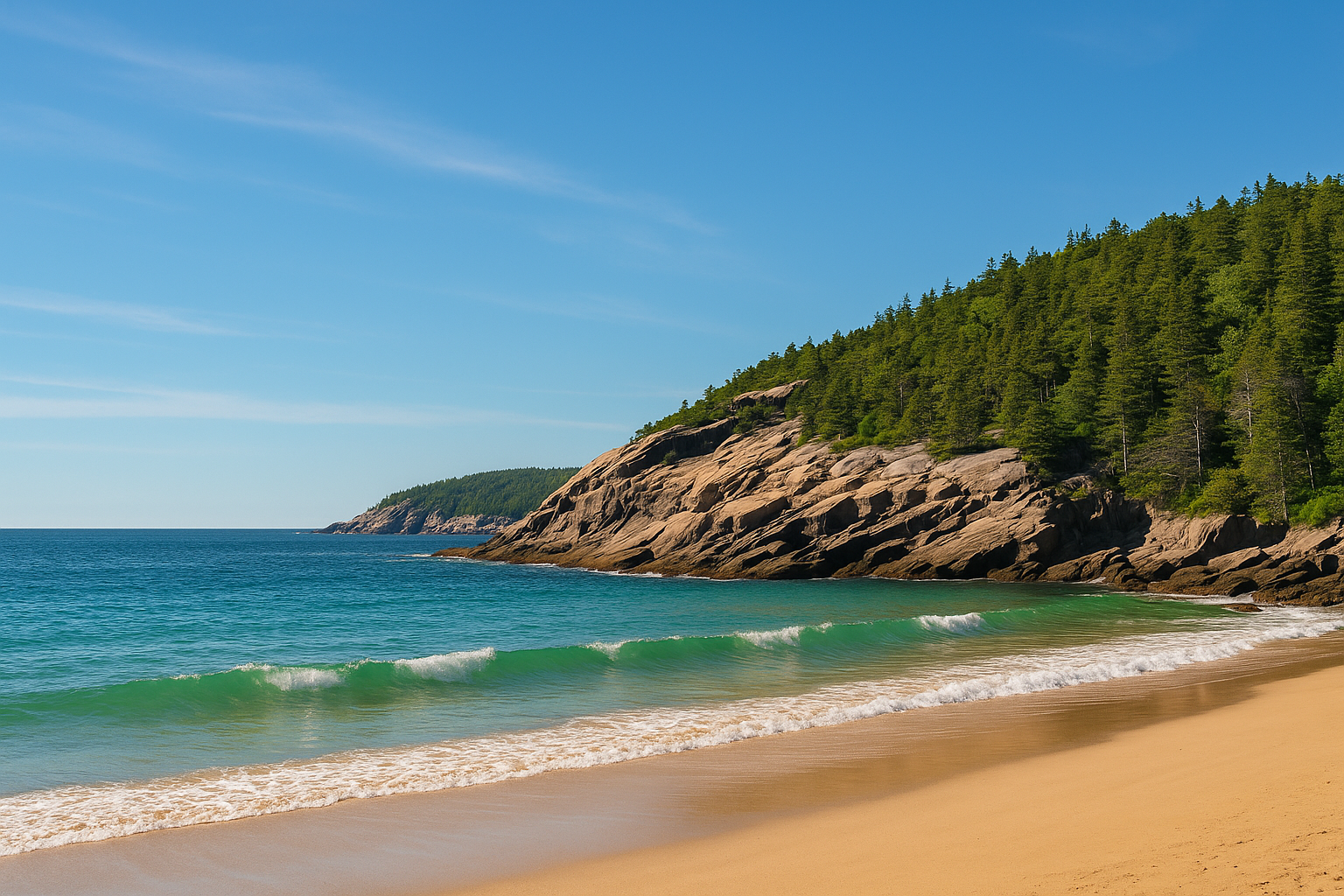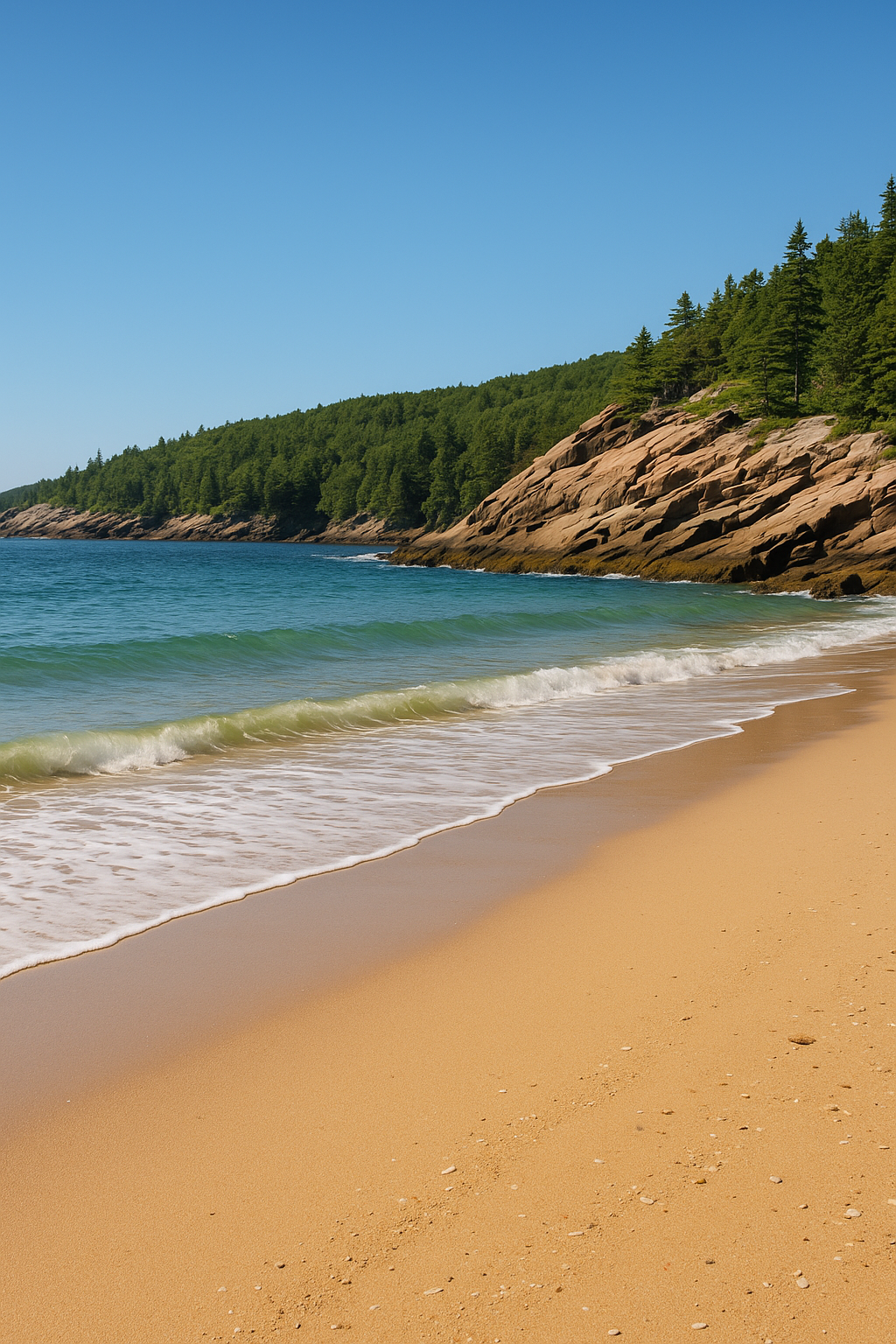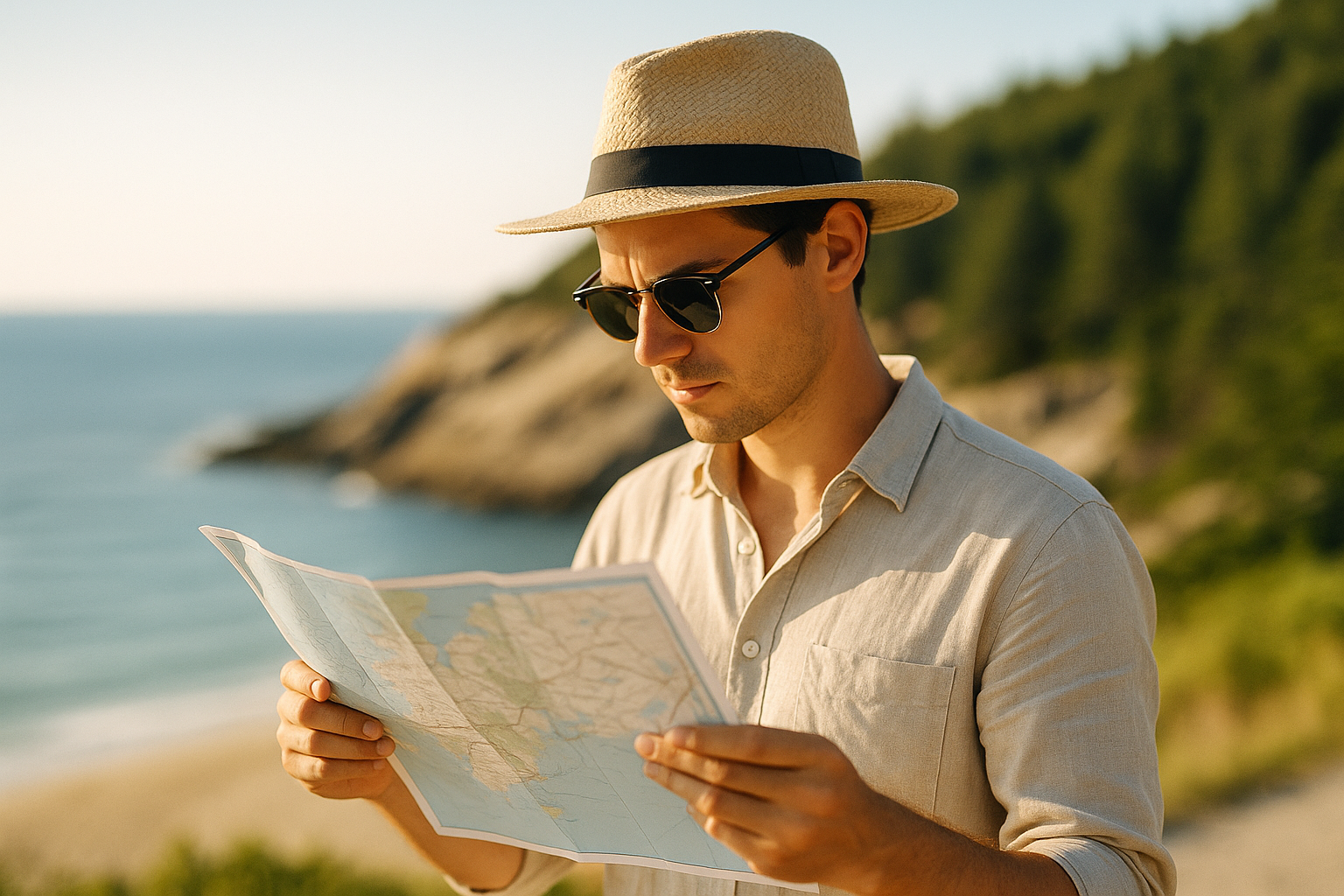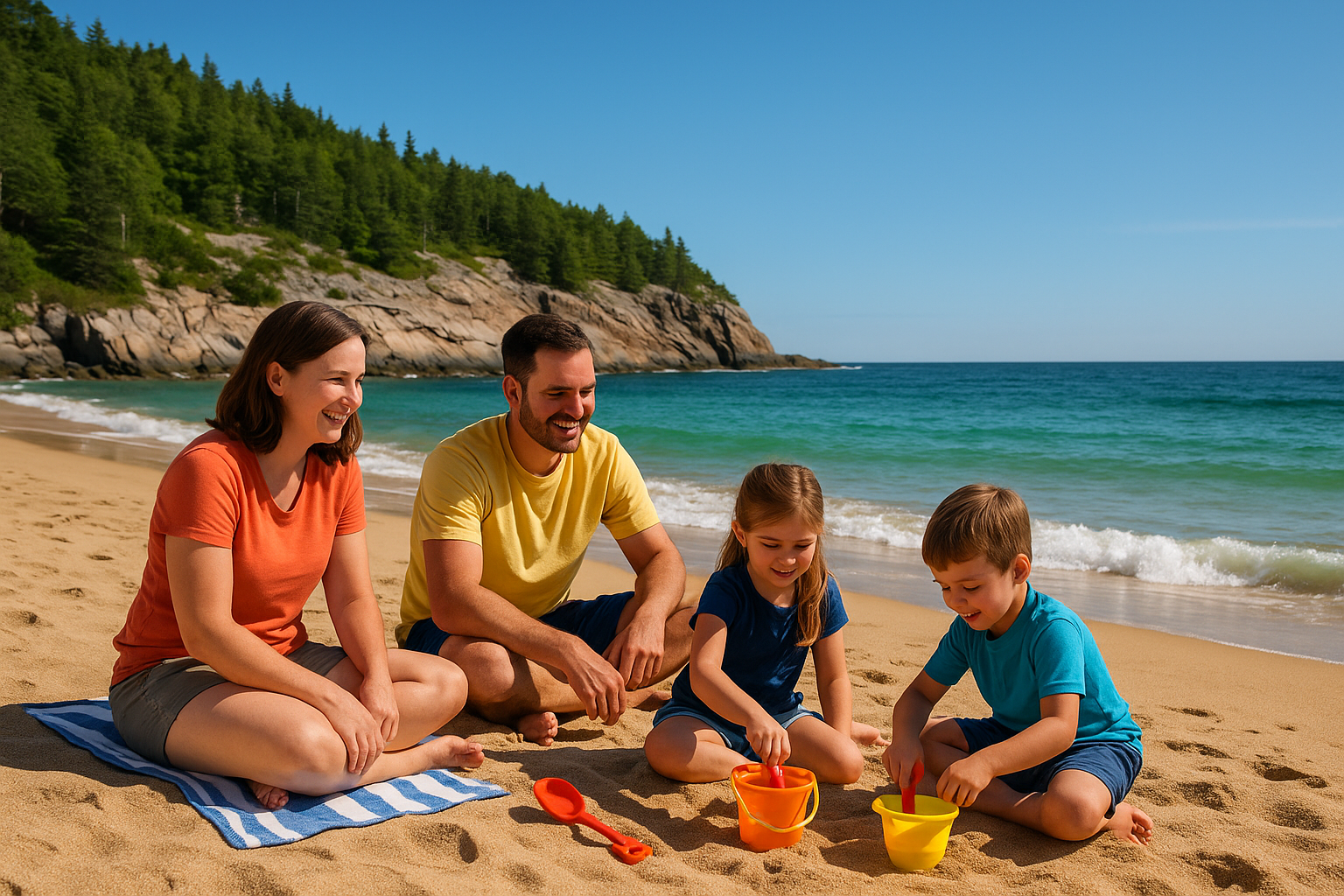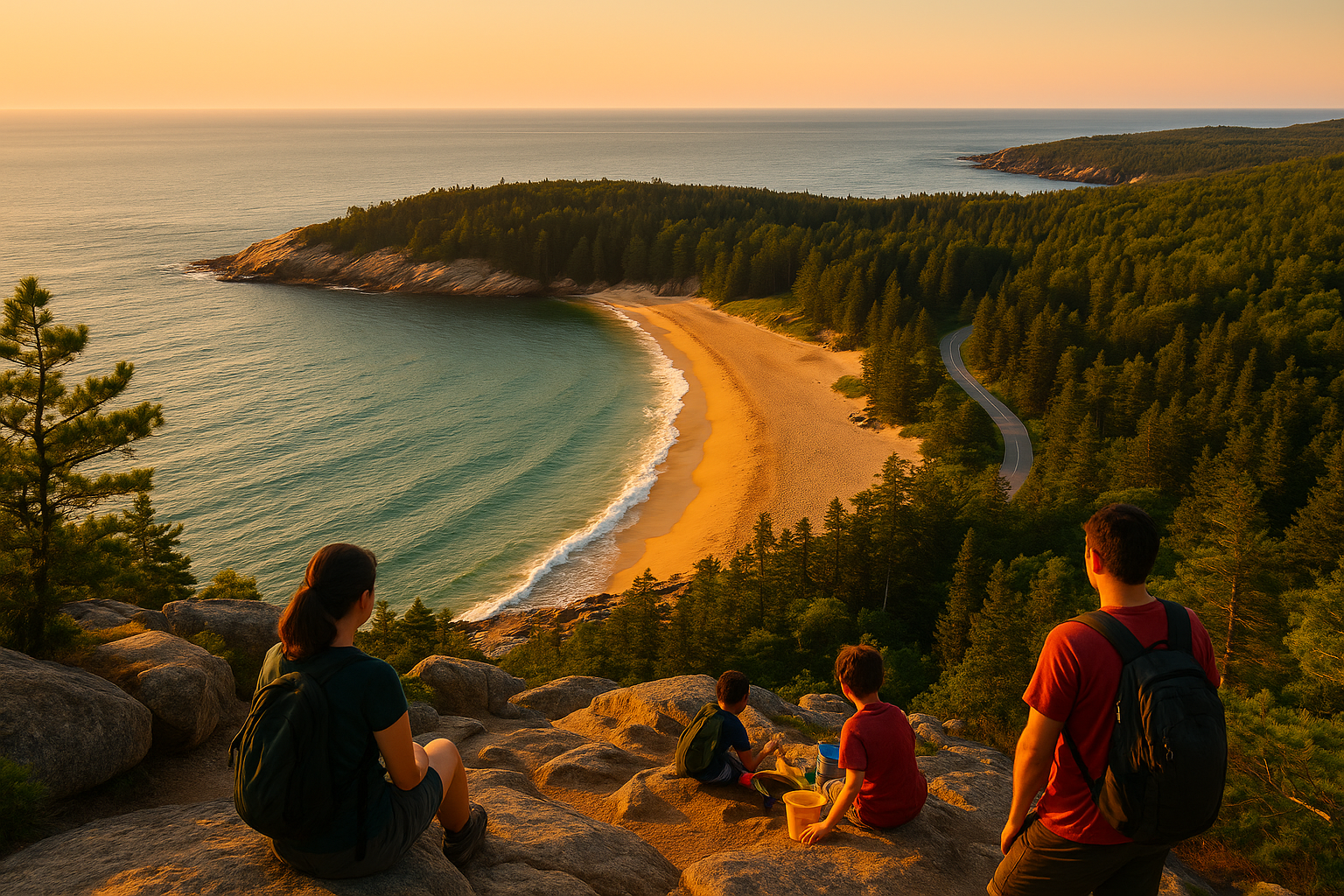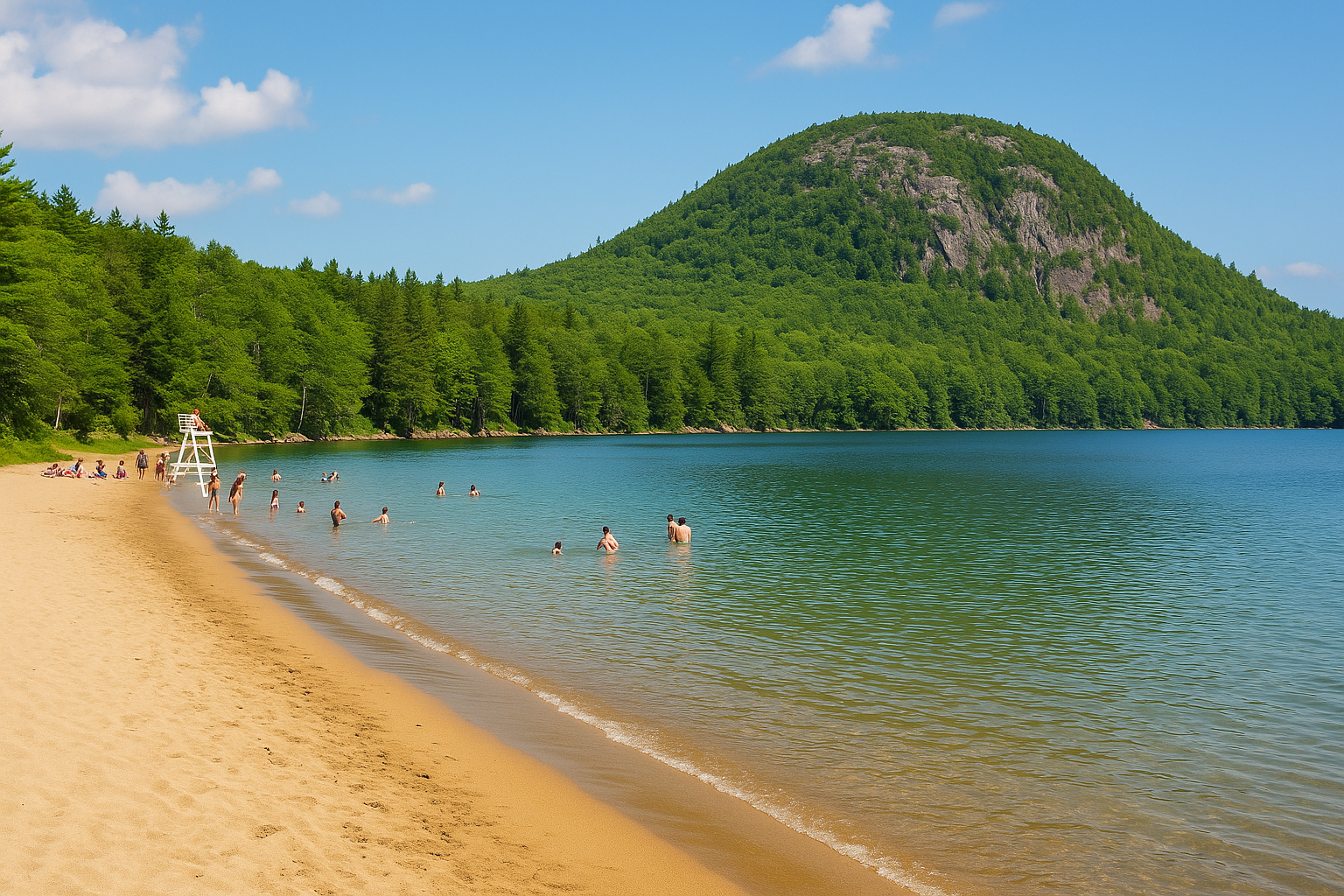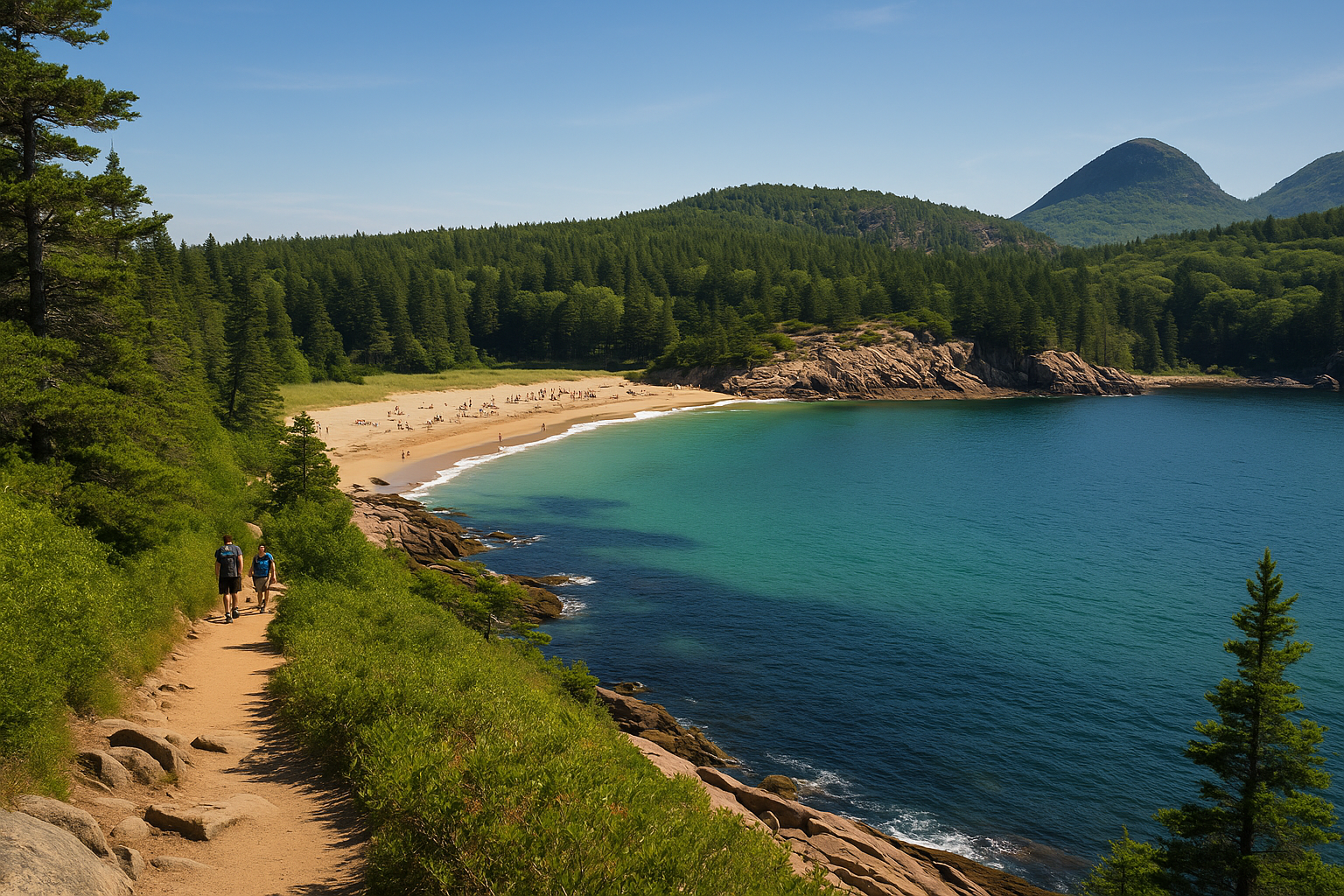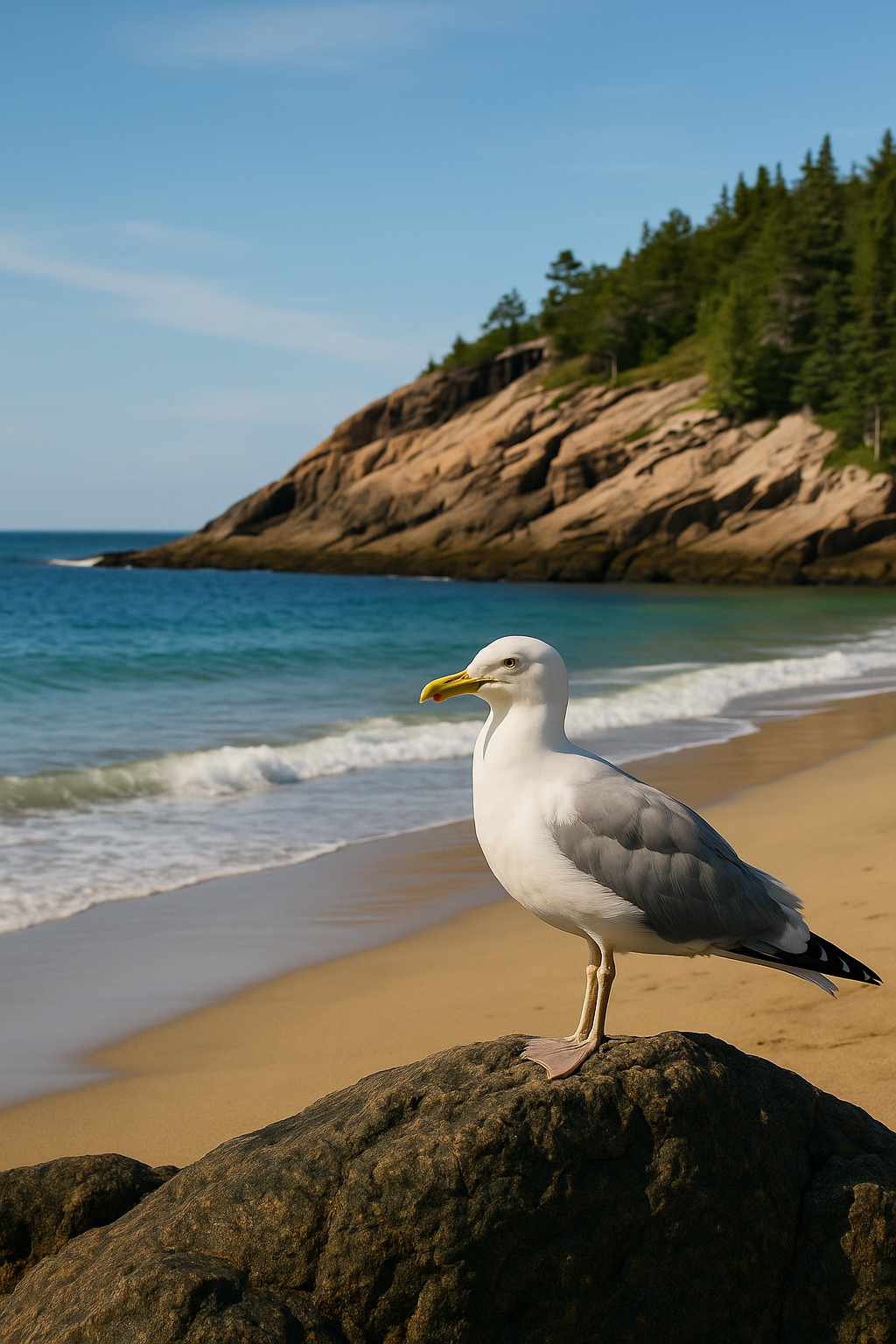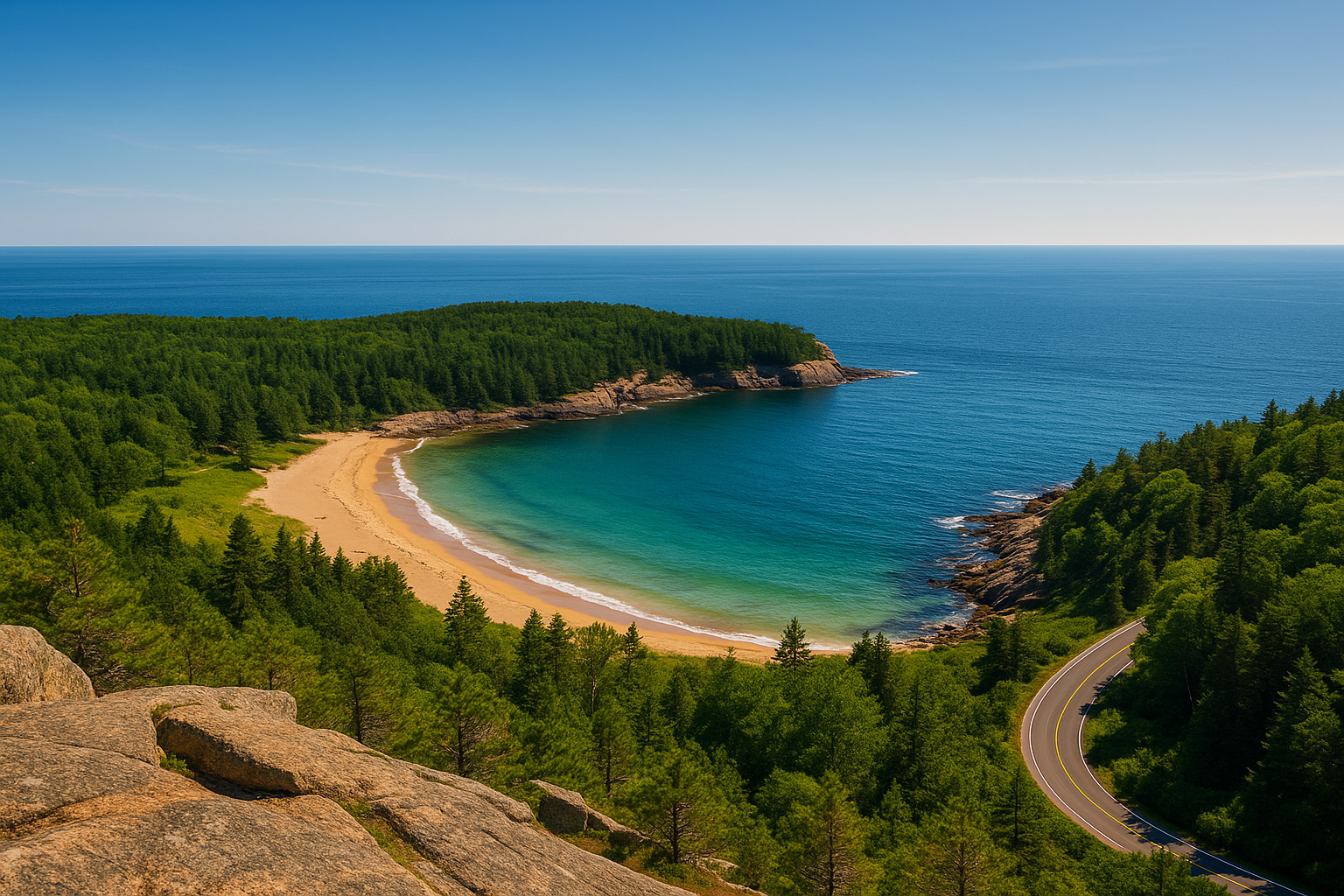🏖️Sand Beach Acadia
Tucked between towering granite cliffs and the sparkling Atlantic Ocean, Sand Beach Acadia National Park is one of the park’s most iconic and beloved destinations. Though it measures just 290 yards in length, this crescent of golden sand leaves a lasting impression on nearly every visitor. Its soft shoreline is a rarity along Maine’s rocky coast, making it a true natural treasure.
The scene here is unforgettable: waves roll in with a steady rhythm, gulls circle overhead, and the salty breeze carries the scent of the ocean. In summer, you’ll find families picnicking on the sand, couples strolling hand in hand, and adventurers cooling off after a morning hike. The water, fed directly from the Atlantic, is famously chilly — often staying in the 50s even in July and August — but that doesn’t stop brave swimmers from taking a quick dip.
Sand Beach Acadia is more than just a place to spread out a towel. At low tide, the shoreline reveals tidepools where tiny crabs, mussels, and barnacles thrive. On the horizon, you’ll spot the Porcupine Islands dotting Frenchman Bay, while behind you rise the dramatic granite cliffs that give this beach its sheltered, secluded feel.
Whether you’re here to soak up the sun, wander along the shoreline with a camera, or simply pause to breathe in the salt air and let the surf wash over your feet, Sand Beach belongs on every Acadia itinerary. It’s the perfect blend of relaxation and scenery, a coastal gem that captures the essence of what makes Acadia so magical.
🏖️ Sand Beach Acadia – A Rare Sandy Shore in Maine
While most of Maine’s rugged coastline is defined by jagged cliffs and wave-battered granite, Sand Beach Acadia National Park is a rare and enchanting exception. Nestled within a sheltered cove, this crescent of golden shoreline offers visitors something almost unheard of along the Downeast coast — soft sand beneath their feet. Measuring just 290 yards in length, it may be small, but it has become one of Acadia’s most iconic and beloved destinations.
What makes Sand Beach Acadia so special is not just its rarity, but its very makeup. Unlike most sandy stretches that are dominated by quartz grains, Sand Beach Maine is composed of crushed seashells mixed with tiny fragments of rock. Over thousands of years, the relentless rhythm of the Atlantic has ground shells and stones together, slowly creating the fine, light-colored texture that feels warm and inviting underfoot. Each grain tells the story of time, tide, and transformation — a natural wonder shaped by the meeting of land and sea.
The surrounding headlands act as protective arms, sheltering the beach from the ocean’s fiercest swells and giving it a calmer, more intimate atmosphere than Maine’s open shores. This protection makes Sand Beach a favorite spot for picnics, quiet walks, and simply pausing to soak in the sound of waves rolling ashore. On hot summer days, visitors often test the water, though the Atlantic here rarely rises above 50–55°F, even in July and August. For some, that invigorating chill is part of the experience — a quick, bracing dip that becomes a memory of its own.
Beyond the shoreline, the views are classic Acadia. Looking out across Frenchman Bay, the horizon stretches wide and open, dotted with the Porcupine Islands in the distance. Turn inland, and your eyes are drawn upward to The Beehive, one of Acadia’s most photographed hiking peaks. From this vantage point, the contrast is striking: golden sand underfoot, deep blue sea ahead, and rugged granite cliffs and summits rising all around.
Whether you come to Sand Beach Acadia for its geology, its scenery, or its sense of calm, it is a place that captures the essence of Acadia in a single glance. It’s more than just a beach — it’s a rare treasure on Maine’s rocky coast, a natural amphitheater where ocean, cliffs, and sky come together in harmony. For many visitors, it’s not only a stop on their Acadia itinerary, but one of the most unforgettable experiences of the park.
📍 Where Sand Beach Is Located
When you arrive on Mount Desert Island via Route 3, your first essential stop should be the Hulls Cove Visitor Center — Acadia’s main hub for orientation. Here, you can grab free maps, confirm tide times, and get up-to-date advice directly from park rangers. It’s also a convenient place to use restrooms, refill your water bottles, and browse exhibits that introduce you to the park’s history and wildlife. Spending a few minutes here helps you start your visit with confidence before you venture deeper into the park.
From Hulls Cove, the adventure begins along the famous Park Loop Road. This 27-mile scenic drive is an attraction in itself, winding south through thick spruce forests, past granite cliffs, and along stretches of open coastline where the Atlantic crashes against the rocks. The drive southbound is one-way for much of its length, which makes it easy to relax and enjoy the sweeping views without worrying about oncoming traffic. Windows down, salt air in your lungs, the road itself sets the stage for what lies ahead.
About four miles (6.4 km) in, you’ll pass trailheads for two of Acadia’s most popular hikes: The Beehive, a thrilling iron-rung climb with panoramic views, and Gorham Mountain, a more moderate trail with equally stunning scenery. This stretch of road is where anticipation builds — keep your eyes open for signs directing you toward Sand Beach. Soon, the road dips into a cove framed by dramatic headlands, and you’ll catch your first glimpse of one of Acadia’s most beloved spots.
The Sand Beach Parking Lot Acadia sits at the heart of this area. It’s the best place to leave your car if you plan to visit the beach, and it also serves as a convenient jumping-off point for nearby trails. From here, you can cross directly to the Beehive Trailhead, follow the gentle Ocean Path along the coast, or simply head straight for the shoreline. Because of its central location, the lot fills quickly — often by mid-morning during the summer months — so arriving early or visiting later in the day can make your experience much smoother.
From the parking lot, it’s only a short walk down a paved path before the trees part to reveal a breathtaking sight: a 290-yard crescent of golden sand, rare along Maine’s rocky coastline, hugged by Great Head to the east and granite outcrops to the west. The surf rolls in with a steady rhythm, filling the cove with its constant roar, while the crisp scent of pine mixes with salt spray in the air. Standing here, with ocean before you and mountains behind you, you’ll understand immediately why Sand Beach has become one of Acadia’s most photographed and unforgettable places.
🚗 Parking Tip
The Sand Beach Parking Lot Acadia is one of the busiest in Acadia, and it fills up fast during peak summer months. By mid-morning — usually between 9 a.m. and noon — spaces can be scarce, and circling the lot often leads to frustration. To make your visit smoother, try to arrive early in the morning before the crowds roll in, or later in the afternoon once the turnover begins.
If the lot is full, don’t stress — you still have options. The free Island Explorer shuttle runs frequently during the summer season and drops passengers right at the Sand Beach entrance. It’s a convenient, eco-friendly alternative that saves you the hassle of waiting for a space, and it allows you to relax and enjoy the scenery without worrying about parking.
For many visitors, taking the shuttle or planning around peak hours makes the difference between a rushed stop and a relaxed, memorable visit to one of Acadia’s most iconic spots.
🏖️ Things to Do at Sand Beach
There’s much more to Sand Beach Acadia than simply laying down a towel — though that’s certainly one of the simplest and most enjoyable options. This little cove offers a variety of experiences for visitors of all ages and interests.
- Relax on the sand – Spread out a blanket and enjoy the warmth of the sun while waves roll steadily in from the Atlantic. The surrounding cliffs create a natural amphitheater, making this a surprisingly peaceful spot despite its popularity.
- Explore tide pools – At low tide, the rocky edges of the beach reveal miniature worlds filled with life. Starfish cling to stones, crabs scuttle between cracks, and colorful seaweed sways with the water. For families, this is a favorite hands-on way to introduce kids to the park’s marine ecology.
- Hike nearby trails – Sand Beach is also a gateway to some of Acadia’s best walks. The Ocean Path begins right here and follows the shoreline past Thunder Hole and on to Otter Cliff. For a more adventurous option, the Beehive Trail rises directly behind the beach. Though short, this iron-rung climb is steep and exhilarating, with views that sweep across the entire cove.
- Photography – From dawn to dusk, Sand Beach rewards photographers. Early morning light paints the granite cliffs with a warm golden glow, while foggy days soften the scene into a dreamlike landscape. Whether you’re capturing tidepools up close or panoramic shots of the bay, this spot delivers endless inspiration.
🌤️ Best Time to Visit Sand Beach
Sand Beach Acadia is beautiful year-round, but each season offers its own unique atmosphere. Whether you’re planning a summer family outing or a quiet winter walk, here’s what to expect through the seasons:
- Summer (June–August) – This is the most popular time to visit, when daytime highs often reach the 70s–80s°F (21–27°C). Long, sunny days make it perfect for swimming, sunbathing, and family picnics by the water. The parking lot fills quickly, especially by mid-morning, so arriving before 9 a.m. or later in the afternoon is the best way to secure a spot. Expect the beach to be lively, with kids building sandcastles, hikers cooling off after the Beehive climb, and plenty of photo opportunities under clear blue skies.
- Fall (September–October) – Cooler, crisp air makes autumn one of the most rewarding times to visit. The surrounding hills ignite with fiery reds, oranges, and golds, creating a stunning frame around the cove. It’s a favorite season for photographers, and for hikers looking to combine a stroll on the beach with treks up the Beehive or Great Head. Crowds thin after Labor Day, leaving the sand far less crowded, and the cooler weather makes for comfortable outdoor exploring.
Outside of the peak summer and fall months, Sand Beach offers a calmer, less crowded experience that highlights its quieter beauty.
- Spring (May–early June) – Spring is Sand Beach at its quietest. Mornings are cool, afternoons pleasant, and the trails burst with fresh green foliage and wildflowers. The ocean remains cold — not ideal for swimming — but this is a perfect season for peaceful walks, wildlife spotting, and photography without the summer bustle. With fewer visitors, you may even feel like you have the entire cove to yourself.
- Winter (November–March) – While not a season for swimming, winter transforms Sand Beach into a dramatic and almost otherworldly scene. Snow and ice trace the cliffs, and heavy Atlantic swells crash against the shore in spectacular displays of power. You’ll likely have the beach to yourself, making it an atmospheric place for photography, reflection, or simply listening to the roar of the waves. Just take care — icy paths and cold winds mean preparation is essential.
🧭 Tips for Visiting Sand Beach
A trip to Sand Beach Acadia is always memorable, but a little preparation goes a long way. Keep these tips in mind to make the most of your visit:
- Dress in layers – Even on sunny summer days, the Atlantic breeze can make the air feel surprisingly cool, especially in the mornings and late afternoons. A light jacket or sweatshirt over a T-shirt gives you flexibility to adjust as the temperature shifts.
- Bring water shoes – The rocky edges of Sand Beach are worth exploring, especially at low tide, but the stones can be slippery or sharp. Water shoes protect your feet and give you better traction, making it easier to wander tide pools and coves safely.
- Keep a safe distance from the surf – Waves here can be unpredictable, with sudden larger swells that catch visitors off guard. During rough conditions, stand well back, and never turn your back on the ocean — it only takes one wave to surprise you.
- Check tide schedules – Low tide transforms the beach, revealing tide pools filled with starfish, crabs, barnacles, and colorful seaweed. Aim to arrive about an hour before low tide for the longest window to explore before the water begins to rise again.
- Pack out all trash – Sand Beach is part of a fragile coastal ecosystem, and keeping it pristine is everyone’s responsibility. Carry out everything you bring in — from snack wrappers to water bottles — to help protect wildlife and preserve the beach for future visitors.
Other Beaches Near Sand Beach
While Sand Beach is the most famous, it’s not the only coastal treasure in Acadia:
Echo Lake Beach – A rare freshwater swimming spot in the park, Echo Lake Beach offers calm, warmer waters that are perfect for families and anyone who finds the Atlantic a bit too chilly. The sandy shore is framed by cliffs and forest, creating a scenic backdrop, and lifeguards are often on duty in summer for added safety.
Hunters Beach – A peaceful pebble beach hidden along the southern shore, reached by a short forest trail. The rounded stones create a soothing sound as waves wash over them, and the surrounding spruce trees make it feel like a secluded coastal hideaway.
Little Hunters Beach – Even more tucked away than its larger namesake, this small cove is accessible via a stone stairway off Park Loop Road. It’s best visited at low tide, when the retreating water reveals colorful pebbles and intricate rock formations.
Boulder Beach – Aptly named for its field of smooth, rounded boulders, this spot faces east and is famous for catching the first light of day. Photographers gather here at sunrise to capture the golden glow on the rocks and nearby Otter Cliffs, but it’s also a beautiful place to simply sit and listen to the surf.
Seal Harbor Beach – Just outside Acadia’s official boundary, Seal Harbor Beach offers a quieter, small-town vibe within a short drive of Sand Beach. At low tide, the sandy stretch widens to reveal tidepools, and the nearby village makes it easy to pair a beach stop with dining, lodging, or a stroll along the harbor. While it’s not technically inside the park, it’s a convenient and scenic option if you’re exploring the eastern side of Mount Desert Island.
Exploring a few of these along with Sand Beach Acadia gives you a deeper appreciation for the park’s coastal variety, from sandy coves to rugged, rock-strewn shores.
🌅 Bringing Sand Beach Into Your Acadia Adventure
Whether you begin your morning with a sunrise walk across the sand or end your day with a peaceful evening stroll, Sand Beach Acadia is perfectly placed to fit into a full day of exploring Acadia’s east side. The sheltered cove isn’t just a destination on its own — it’s also a natural gateway to some of the park’s most iconic experiences.
From the beach, it’s only steps to the start of Ocean Path, a scenic coastal walk that winds past Thunder Hole and continues toward the dramatic cliffs of Otter Point. If you’re feeling adventurous, the trailhead for The Beehive sits just across the road. This short but steep climb rewards hikers with sweeping views of Sand Beach below, Great Head rising to the east, and Frenchman Bay stretching toward the horizon.
For those who prefer to take in the sights at a slower pace, simply continuing along the Park Loop Road links you with other must-see spots, from Jordan Pond to Cadillac Mountain. In this way, a stop at Sand Beach becomes more than just an afternoon on the sand — it anchors your journey through Acadia’s rugged coastline, tying together trails, viewpoints, and the raw beauty of Maine’s seashore.
By weaving Sand Beach into your itinerary, you’ll experience not only the unique charm of the beach itself but also the dramatic landscapes that make Acadia unforgettable.
History of Sand Beach Acadia
The story of Sand Beach Acadia is as captivating as its scenery. This rare 290-yard crescent of sand was not deposited quickly, but patiently sculpted over thousands of years. Relentless Atlantic waves pounded the shoreline, grinding fragile seashells and shards of Acadia’s pink granite into fine particles. Over time, these fragments mixed together to form the beach’s distinctive pale hue — a natural process that continues even today. Unlike many sandy stretches around the world, Sand Beach is entirely the work of nature, a harmonious collaboration of tides, currents, and coastal geology.
By the early 1900s, before Acadia was officially designated as a national park, Sand Beach had already become a destination for adventurous summer visitors. Wealthy travelers from New England and beyond arrived in horse-drawn carriages along the network of winding carriage roads. Outings here were both a social occasion and a chance to enjoy the ocean air. Visitors came dressed in their finest beach attire of the era — women in flowing skirts and wide-brimmed hats, men in woolen bathing costumes — spreading blankets on the sand for picnics or strolling along the shore to admire the Atlantic surf.

The 1930s brought lasting changes with the arrival of the Civilian Conservation Corps (CCC). As part of Franklin D. Roosevelt’s New Deal programs, the CCC provided jobs to young men while also improving America’s natural spaces. At Sand Beach, they carefully designed and built stone staircases, walking paths, and parking areas. Their work wasn’t just practical — it was also intentional in style, blending seamlessly with the rugged landscape. These efforts protected the fragile dunes and surrounding forest from heavy use, ensuring that the beach could remain accessible without being damaged.
Today, visitors arrive in cars and tour buses rather than carriages, but the essence of the experience is unchanged. The salty breeze still carries across the cove, granite cliffs still rise protectively around the sand, and the sense of wonder remains the same. Standing on Sand Beach in Acadia, it’s easy to imagine the generations before you who spread blankets here, marveled at the ocean’s power, and felt the same quiet joy in discovering this rare sandy gem on Maine’s rocky coast.
• Only about 10% of Sand Beach is actually sand — the rest is finely ground seashells and fragments of pink granite.
• The Civilian Conservation Corps’ 1930s work at Sand Beach is still considered one of the best examples of “rustic” park design, blending stairways, paths, and parking into the landscape so seamlessly it feels timeless.
• Even in midsummer, the Atlantic here rarely warms above 55°F, making Sand Beach one of the chilliest swimming spots in the U.S.
• Sand Beach is one of only a handful of natural sandy beaches along Maine’s 3,478-mile coastline.
🐚 Wildlife Around Sand Beach
While Sand Beach Acadia is best known for its golden shoreline and dramatic setting, the surrounding ecosystem is every bit as captivating. On calm summer mornings, the skies above the cove are alive with gulls and cormorants, their sharp dives sending ripples across the shallows. Occasionally, a bald eagle glides overhead, a regal silhouette against the sky and a reminder of Acadia’s untamed heritage.
At either end of the beach, rocky outcrops and tide pools reward those who pause and look closely. Here, tiny crabs scuttle beneath ribbons of seaweed, periwinkles cling stubbornly to wet rock, and brightly colored sea stars spread across crevices like living jewels. Each pool is constantly reshaped by the incoming and outgoing tide, so no two visits reveal quite the same array of marine life.
Offshore, harbor seals are sometimes seen bobbing in the swells, their whiskered faces emerging briefly before disappearing again with an elegant dive. In late summer, migrating shorebirds such as sandpipers and plovers pause here to rest and refuel before their long journeys south. At quieter times of day, patient visitors who move slowly along the shore may be rewarded with intimate glimpses of these birds darting in and out of the foamy surf.
This rich blend of marine, bird, and intertidal life makes Sand Beach not only a place to relax, but also a living classroom of coastal ecology — a reminder that every tide brings with it a new story to discover.
• In the air: Gulls, cormorants, bald eagles
• On the shore: Sandpipers, plovers (late summer)
• In the tide pools: Crabs, periwinkles, sea stars, seaweed
• Offshore: Harbor seals bobbing in the swells
🗺️ Pairing Sand Beach with Nearby Attractions
A visit to Sand Beach Acadia can easily be combined with several of the park’s most iconic highlights. Just steps from the shoreline, the Ocean Path invites you to wander south along the rugged coast. Within minutes you’ll arrive at Thunder Hole, where waves crash into a natural inlet and erupt in a thunderous roar during high surf. Continue farther and the trail delivers you to Otter Cliff, one of the most dramatic headlands on the entire U.S. East Coast.
For hikers seeking more of a challenge, the Beehive Trail begins right across from the Sand Beach parking lot. This short but steep route uses iron rungs to guide you up the cliffside, rewarding the climb with sweeping views over Sand Beach, Great Head, and Frenchman Bay — a perspective few visitors forget.
Whether you linger on the sand, explore tide pools, or set out on nearby trails, Sand Beach is more than just a stop along the Park Loop Road — it’s a gateway into Acadia’s most unforgettable coastal landscapes.
👉 Ready to keep exploring? Discover more of Acadia National Park’s best attractions and start planning your perfect adventure.
- NPS: Sand Beach — Official page with details on beach access, swimming, facilities, and seasonal conditions.
- AcadiaMagic: Sand Beach — Local guide with photos, directions, and tips for visiting this iconic stretch of shoreline.
